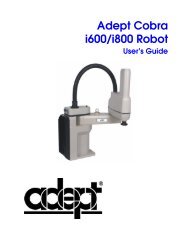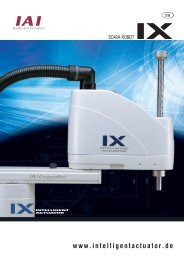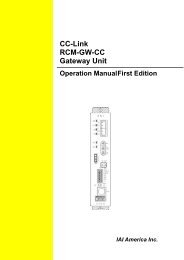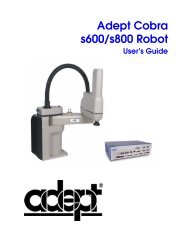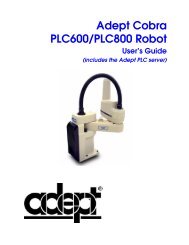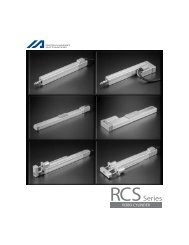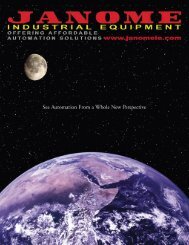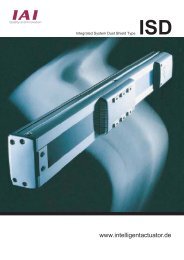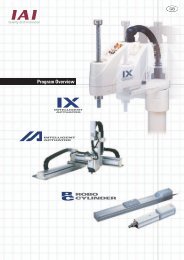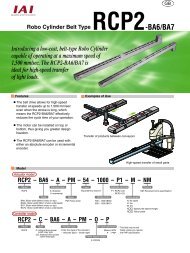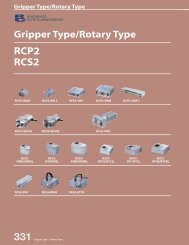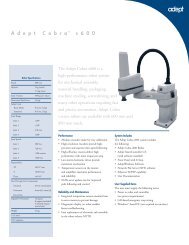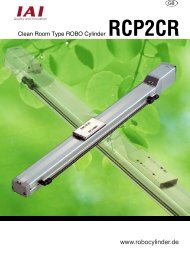www . intelligentactuator . de Long Stroke and High-Speed ...
www . intelligentactuator . de Long Stroke and High-Speed ...
www . intelligentactuator . de Long Stroke and High-Speed ...
Create successful ePaper yourself
Turn your PDF publications into a flip-book with our unique Google optimized e-Paper software.
4<br />
Explanation of main unit options<br />
Brakes<br />
Mo<strong>de</strong>l<br />
B<br />
Explanation<br />
This is a structure that holds the sli<strong>de</strong>r so that if the actuator is used vertically <strong>and</strong> the power is switched Off or the servo goes Off, the sli<strong>de</strong>r does not fall <strong>and</strong> damage<br />
installed items. In the NS series vertical specifications (LZMS/LZMM), brakes are st<strong>and</strong>ard equipment. (Brakes are not set for the horizontal specifications.)<br />
Creep sensor<br />
Mo<strong>de</strong>l<br />
C<br />
Explanation<br />
When the return-to-origin operation is carried out with the incremental specifications, in or<strong>de</strong>r to shorten the return-to-origin time, the sli<strong>de</strong>r is moved at high speed<br />
to just before the position <strong>and</strong> when it passes this sensor, the speed is dropped to resume normal return-to-origin operations. Since this sensor is mounted within the<br />
actuator itself, it does not affect the appearance or external dimensions.<br />
St<strong>and</strong>ard cableveyor installation direction change/extension cableveyor installation<br />
Mo<strong>de</strong>l<br />
CT2 / CT3 / CT4 (st<strong>and</strong>ard cableveyor installation direction)<br />
ET1 / ET2 / ET3 / ET4 (exten<strong>de</strong>d cableveyor installation direction)<br />
Explanation<br />
The cableveyor installation direction can be selected from the following four types (including the st<strong>and</strong>ard installation direction).<br />
[Installation direction]<br />
[Cableveyor internal dimensions]<br />
Installation direction 1 (st<strong>and</strong>ard)<br />
St<strong>and</strong>ard cableveyor: No symbol<br />
Exten<strong>de</strong>d cableveyor: Symbol ET1<br />
Installation direction 2 (st<strong>and</strong>ard; different use)<br />
St<strong>and</strong>ard cableveyor: Symbol CT2<br />
Exten<strong>de</strong>d cableveyor: Symbol ET2<br />
<br />
Installation direction 3 (st<strong>and</strong>ard; reverse origin)<br />
St<strong>and</strong>ard cableveyor: Symbol CT3<br />
Exten<strong>de</strong>d cableveyor: Symbol ET3<br />
Installation direction 4 (CT2, origin reversed)<br />
St<strong>and</strong>ard cableveyor: Symbol CT4<br />
Exten<strong>de</strong>d cableveyor: Symbol ET4<br />
<br />
Origin limit switch<br />
Mo<strong>de</strong>l<br />
L<br />
Explanation<br />
Normal NS series return-to-origin operations use the "push contact technique" in which the origin is reached by bringing the sli<strong>de</strong>r in contact with a stopper, inverting,<br />
then <strong>de</strong>tecting the Z phase. L (origin limit switch) is the option for executing the return-to-origin operation without contact by <strong>de</strong>tecting using a proximity sensor, then<br />
inverting. Since origin limit switch is mounted within the actuator itself, it does not affect the appearance or external dimensions.



